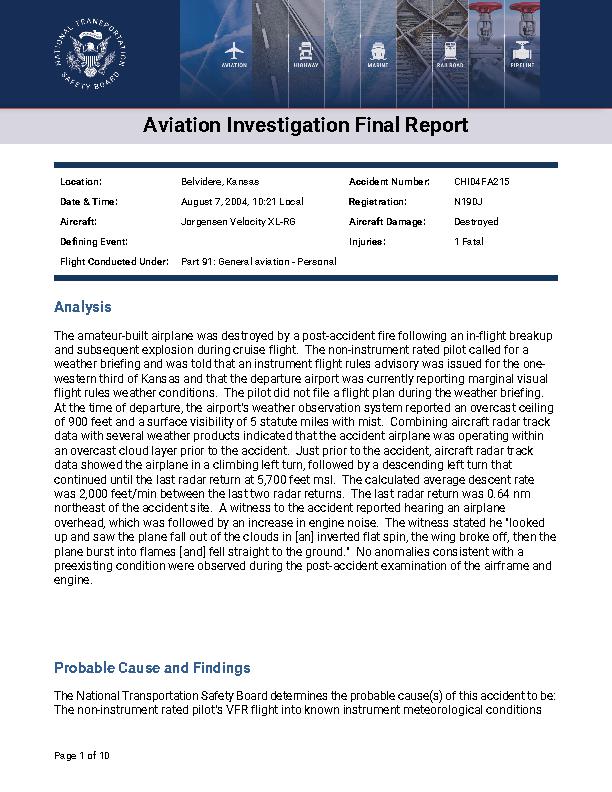
This information is added by users of ASN. Neither ASN nor the Flight Safety Foundation are responsible for the completeness or correctness of this information.
If you feel this information is incomplete or incorrect, you can submit corrected information.
| Date: | Saturday 7 August 2004 |
| Time: | 10:21 |
| Type: |  Velocity XL RG |
| Owner/operator: | Private |
| Registration: | N190J |
| MSN: | 1 |
| Total airframe hrs: | 210 hours |
| Engine model: | Lycoming IO-540-C4B5 |
| Fatalities: | Fatalities: 1 / Occupants: 1 |
| Other fatalities: | 0 |
| Aircraft damage: | Destroyed |
| Category: | Accident |
| Location: | Belvidere, KS -
 United States of America United States of America
|
| Phase: | En route |
| Nature: | Private |
| Departure airport: | Dodge City, KS (DDC) |
| Melbourne, FL (MLB) | |
| Investigating agency: | NTSB |
| Confidence Rating: |
The amateur-built airplane was destroyed by a post-accident fire following an in-flight breakup and subsequent explosion during cruise flight. The non-instrument rated pilot called for a weather briefing and was told that an instrument flight rules advisory was issued for the one-western third of Kansas and that the departure airport was currently reporting marginal visual flight rules weather conditions. The pilot did not file a flight plan during the weather briefing. At the time of departure, the airport's weather observation system reported an overcast ceiling of 900 feet and a surface visibility of 5 statute miles with mist. Combining aircraft radar track data with several weather products indicated that the accident airplane was operating within an overcast cloud layer prior to the accident. Just prior to the accident, aircraft radar track data showed the airplane in a climbing left turn, followed by a descending left turn that continued until the last radar return at 5,700 feet msl. The calculated average descent rate was 2,000 feet/min between the last two radar returns. The last radar return was 0.64 nm northeast of the accident site. A witness to the accident reported hearing an airplane overhead, which was followed by an increase in engine noise. The witness stated he "looked up and saw the plane fall out of the clouds in [an] inverted flat spin, the wing broke off, then the plane burst into flames [and] fell straight to the ground." No anomalies consistent with a preexisting condition were observed during the post-accident examination of the airframe and engine.
Probable Cause: The non-instrument rated pilot's VFR flight into known instrument meteorological conditions and his failure to maintain aircraft control which resulted in an inverted flat spin, in-flight breakup, and explosion.
Accident investigation:
 |
|
Sources:
NTSB: https://www.ntsb.gov/_layouts/ntsb.aviation/brief.aspx?ev_id=20040825X01289&key=1
Location
Revision history:
| Date/time | Contributor | Updates |
|---|---|---|
| 28-Oct-2008 00:45 | ASN archive | Added |
| 21-Dec-2016 19:24 | ASN Update Bot | Updated [Time, Damage, Category, Investigating agency] |
| 07-Dec-2017 18:18 | ASN Update Bot | Updated [Source, Narrative] |
Corrections or additions? ... Edit this accident description
The Aviation Safety Network is an exclusive service provided by:


 ©2024 Flight Safety Foundation
©2024 Flight Safety Foundation